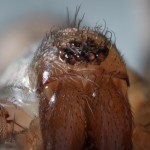We are just back from our second trip to India and, once again, had a thoroughly enjoyable time. I thought it would be interesting to start with some numbers:
- Pictures taken: 3,413
- Separate destinations: 7
- Approximate distance transferring between destinations: 865km
- Leopards seen: 1
- Elephants washed: 1
This is the fourth long haul holiday in a row that we have used a well known tailor-made holiday operator in the UK for, and we have thoroughly enjoyed the service every time. We had a different mix of venues this time, with simpler accommodation than we might normally aim for [in general], plus a number of homestays for the first time. That said, having just looked through some pictures of what is labelled ‘simple’ – we still weren’t exactly slumming it.
A quick word on the packing. I took my 100-400, 24-105, and 100mm macro lenses, so ‘subsisted’ without my ultra-wide and fast 50. I also took the tripod which served as little more than ballast, given the amount of use it got. I very seldom use it without the 10-22, so it would have been better off at home. I also took my MacBook Air, the first time I’ve ever taken a laptop on holiday, and the significant uptick in the amount of pictures that I took reflects the capacity and ongoing editing that having the machine with me afforded. I was a little bit anxious about it suffering some damage in my camera bag, mainly from getting compressed by the weight of the rest of the kit. I improvised a ‘case’ in the form of a padded envelope with the back of a hardback notebook. In the end it survived unscathed, apart from a slight scratch I managed to inflict with my watch.
The homestays provide a different perspective on the country, and made for a couple of real highlights of the trip. They do throw you into the company of strangers though, which can be something of a mixed blessing. As well as some genuinely interesting people, we did have the pleasure of Mr and Mrs Casually Racist for one stay. Charming…
We flew into Bangalore via Dubai, and jumped straight into the car to Mysore. This made for a long slog: we stayed overnight in a hotel by Heathrow, so door to door, the outbound trip took us something like 22 hours. We stayed in a hotel called the Metropole. It was quite a nice room: a lot of period furniture and high ceilings. To be perfectly honest, it could have been a slum for all that we would have noticed. The first couple of days are a bit of a blur. The buffet food was pretty good for breakfast and lunch once we figured out what we were supposed to do. The evening meals were a la carte, and again very agreeable, but the second night the hotel was noticeably busier, and the service was abysmal. I think we waited for the guts of an hour for our first course to arrive.
We had 3 little excursions in Mysore. We took a run out to a bird sanctuary called Ranganithittu, which is on a lake. We had a boat trip that took about an hour and a half, and it was rich pickings. Spoonbills, various types of eagles, and quite large crocodiles basking in the heat.
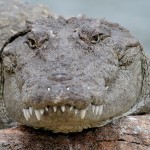
Crocodile at Ranganathittu Sanctuary
This fish eagle was very patient with us. We rowed to within a few feet of him before he decided he’d had enough:
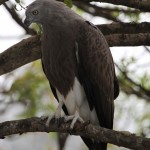
Fish eagle at Ranganathittu Sanctuary
And one more shot from the sanctuary, this one slightly tongue in cheek. There were a lot of fruit bats hanging in one of the trees and, once again, the boat gave us quite good access allowing for the shot below. When I had a look at it on the laptop that evening I was somewhat impressed by this chap’s – how to put this delicately… Shall we say reproductive capabilities commensurate with a larger mammal. So, for the sake of modesty, I’ve photoshopped in some Speedos for him:
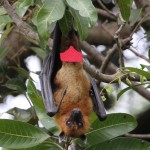
Batman
The wildlife at the sanctuary was very accessible – I’d definitely recommend this for photography. That said, being there in the last week in November means that we caught all of the venues right at the end of the rainy season, and so numbers of visitors were correspondingly low.
We took in a couple of temples, which were pretty interesting. The City Palace is outstanding. Unfortunately, there were restrictions on photography inside the building, but it’s a fascinating tour and well worth a look. I’ve included one picture which I took with my phone [which was allowed]:
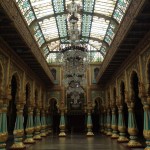
The City Palace, Mysore
From Mysore, we drove to the first of our homestays, which was called Tranquil in Sultan’s Battery. This was fabulous: the house is set in 400 acres, and has walks of varying lengths and elevation mapped out. The food was excellent, and the hosts, Victor and his family, were charming and full of interesting stories.
We did have an interesting little vignette play out on the first afternoon we stayed. We were enjoying tea, when a couple arrived after a very long drive. In the interests of avoiding caricature, I’ll leave out their nationality, but the gentleman had quite a brusque manner. On being greeted by the lady of the house and offered tea, he said ‘I’d like two coffees, one for me and one for my wife. Two. Do you have coffee?’. The rather droll response was ‘this is a coffee plantation’. I nearly bit my tongue off.
Victor happened to ask if we would be interested in washing an elephant, which belonged to one of his friends in a neighbouring plantation. As it has been absolutely weeks since we’d last done it [!] we jumped at the chance. Enter Kiran, who is 55, and works as a crane for a living, with occasional moonlighting for festivals and ceremonies.
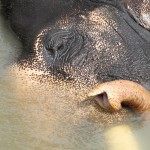
Kiran the elephant
And after his bath:
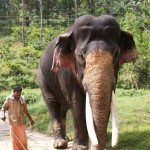
Kiran, post bath
Our next stop was the Nagarhole national park, where we spent a couple of nights at a hotel called the Serai. The rooms were nicely equipped semi-detached bungalows. Food was buffet style and pretty tasty. One thing that we found a little puzzling was that, regardless of whether you ordered rothi, paratha or a naan bread, it always appeared to be the same. We couldn’t quite figure this one out. Anyway, it was good fare.
We had 3 safaris: 2 by jeep, and one by boat. This isn’t for the faint hearted on a number of levels. Some of the jeeps [actually small lorries with open backs for seating] were a little old and had leaf spring suspension. This, combined with a road that would be good for motocross and a 5.45am start, was a bit of a workout! My wife found the boat safari on our second afternoon quite stressful. There were probably about 25 people aboard. The guide made a somewhat half hearted to balance the boat, but as soon as we set off, a few people in family groups swapped places so were canted over at quite an angle. There were some very young children on the boat as well who were quite excitable. It didn’t particularly matter to me but if a tiger had happened to amble down to the water’s edge it might have been a different story.
We were pretty lucky over the course of the 3 trips, and saw a couple of animals that the guide said were very unusual to see [I got the feeling they ‘big up’ rarity though], the highlight of which was a leopard. Unfortunately, he decided to put in an appearance at about 7am, and in a shaded area, which meant that my camera was up in ISO 2000 to 3200 territory. I won’t be printing any of the shots out as A2 posters, but it still made for a very exciting morning. On the basis of some very mixed results [due to lighting conditions] during a jungle walk in Cuba, I decided to set the camera in shutter priority mode with the ISO on auto. There is no point in having a low noise but unusably blurred shot. I’ve also found that I get best results with the 100-400mm at full reach using manual focus, but obviously circumstances will dictate what to start with. So I default to auto, and then if subject looks like it is going to hang around for a while I flick over to manual.
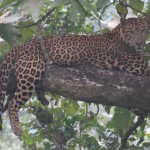
ISO2000, 400mm at f5.6, 1/160 sec
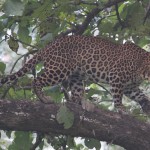
ISO2000, 400mm at f5.6, 1/160 sec
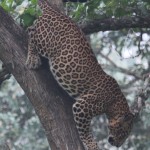
ISO2000, 400mm at f5.6, 1/160 sec
I asked the guide how often he had seen leopards and got an amazingly precise response: 536 times over a 6 year period. The guides are government employees, and I guess they probably record sightings as a way of tracking the population. There are something like 80-90 leopards over the 4,500 square kilometre national park.
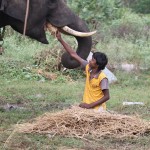
Boy from tribal village feeding elephant
We enjoyed seeing these guys – what appears to be a family of pups with a parent – galloping down to the water. The parent caught a fish very quickly, with the pups looking on with varying degrees of interest. It’s not a great composition [otters can be so difficult to work with :)], but I still quite like the shot.
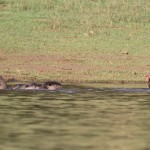
ISO100, 400mm at f6.3, 1/200 sec
It’s quite a tight crop, and at full resolution, it’s telling that the shutter speed is a little too low.
There was the usual selection of exotic waterfowl, but this chap was a new one on me, a painted stork:
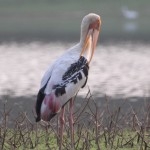
ISO640, 400mm at f6.3, 1/640 sec
I like this silhouetted shot: the boat they are using is a coracle:
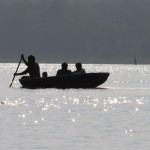
ISO100, 180mm at f14, 1/400 sec
Our next stop was a homestay in Tellicherry. We got the feeling that there weren’t too many European visitors to the city, and I’ve never been to a place where people were so keen to have their photos taken. The homestay itself, called Ayesha Manzil, was in a lovely house – high ceilings, lots of period furniture, and very big rooms. This shot, one of the few outings for my tripod, is a HDR capture of our bedroom:
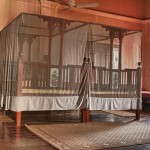
Ayesha Manzil
We had another few outings here, but I’ll start with a cooking lesson we had from the lady of the house. We’ve done three of these now, and it’s interesting to see how the organisers pitch it. One we did in Thailand a few years back was aimed at experienced cooks: I remember beads of sweat breaking when we were asked to do something akin to julienning vegetables. This one was more of a case of watching than doing, but still pretty good fun. Part of the reason that the supervision was rather intense was because some of the dishes that were being prepared were being eaten by everyone who was staying that night [9 people], so there wasn’t room for the type of error that you eat yourself. We’d been to the markets earlier in the day to pick up some of the ingredients.
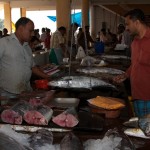
ISO100, 24mm at f8, 1/40 sec + flash
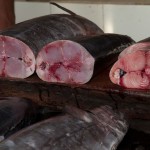
ISO100, 93mm at f8, 1/40 sec + flash
The fish prominent in both of the shots above is kingfish.
Our next outing was to a cigarette factory. The cigarettes, called beedis, are hand rolled, and comprised entirely from tobacco. The local price was 7 rupees for a pack of 12.
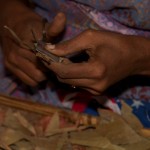
Cutting the tobacco
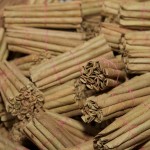
The rolled beedis
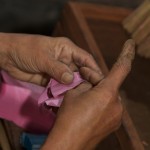
Wrapping the beedis
We also took in a textile factory. Both it and the beedi factory were run as co-ops, with the employees sharing profits [the details of which weren’t disclosed]. We actually had to try to keep a low profile in the beedi factory as there was a downing of tools for a discussion over possible strike action, over the supply of poor quality tobacco.
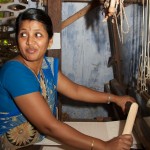
Lady operating loom
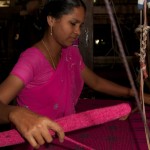
Loom operator
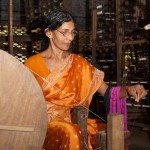
Spinning fibre into thread

Operating foot pedals of the loom
I’m always quite conscious of being intrusive with the camera, which is one of the reasons that I don’t do very much street photography. With the factories, people were asking us to take their picture.
We took in a Theyyam ceremony on the way home:
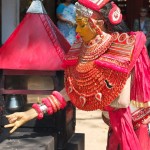
Theyyam ritual
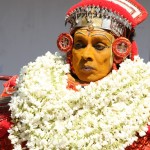
Theyyam ritual
The next leg of the trip took us to the outskirts of Kochin by train. We’d been interested in doing a train journey for quite a while, but with the benefit of hindsight, we’d probably skip doing a trip like the one we did this time. It was an early kickoff to get to the station for 7am. The journey took around six hours to cover something like 245km. The problem was that the carriage wasn’t so much air conditioned as refrigerated, and the windows were so heavily tinted [and quite small] that there wasn’t really that much to see. We were also a bit embarrassed to find that our driver was taking our cases by car to the other end. It was interesting enough, just not really worth going out of our way to do.
The train took us to the last of our 3 homestays at Olavipe. If we had one regret about the holiday it was that we only had one night here. It was fantastic: the house [from its Italian tiles, to the barn owls shuffling around above our room], the charming hosts [from a fabulously successful family], and the beautiful grounds it was set in. Similar to Tranquil, there was a working farm with walks set out, which allowed you to follow the banks of the backwaters. I wish we’d had more time to explore, though I did come across this rather grizzly little number, and the second fruit bat picture of this posting. Don’t enlarge if you are squeamish:
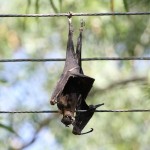
This is an ex parrot!
Unlike the chap above, these are tricky little fellas to get a picture of, very flighty indeed. I’m pretty sure it’s a blue tailed bee eater, and we saw quite a few of them:
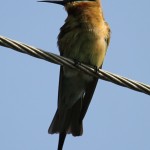
Blue-tailed bee eater
By this stage we were in the home straight of the holiday with a couple of venues coming up that we did last year. First up was a trip on the backwaters on a rice barge. I’m pretty sure that it was identical, down to every course of the meal. But we weren’t complaining, it was really good fun and thoroughly relaxing. The run out in the canoe, about an hour and a half on the canals, was a good opportunity for wildlife.
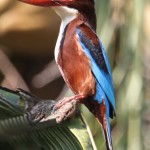
White throated kingfisher
Our last pitstop was at the Marari Beach Resort which is a really lovely hotel. If it had been our first stay, or at the front end of the holiday, we would probably have asked for another room as the vistas out over the drainage ditch didn’t exactly set the world on fire. We stayed in a smarter room on the beach front last year and realised that, lovely as it was, it wasn’t really worth it as we spent no time in the room other than to sleep.
So that was it, another fab holiday in India. Before we left we were talking about our next holiday. I’m keen on India again, my wife is interested in either Cambodia or Laos [or possibly both]. Olavipe creates an interesting problem. If we go back, I want to spend time there. Given that we would probably want to go further north, that would probably take us into the realms of internal flights to fit everything in. We shall see…

